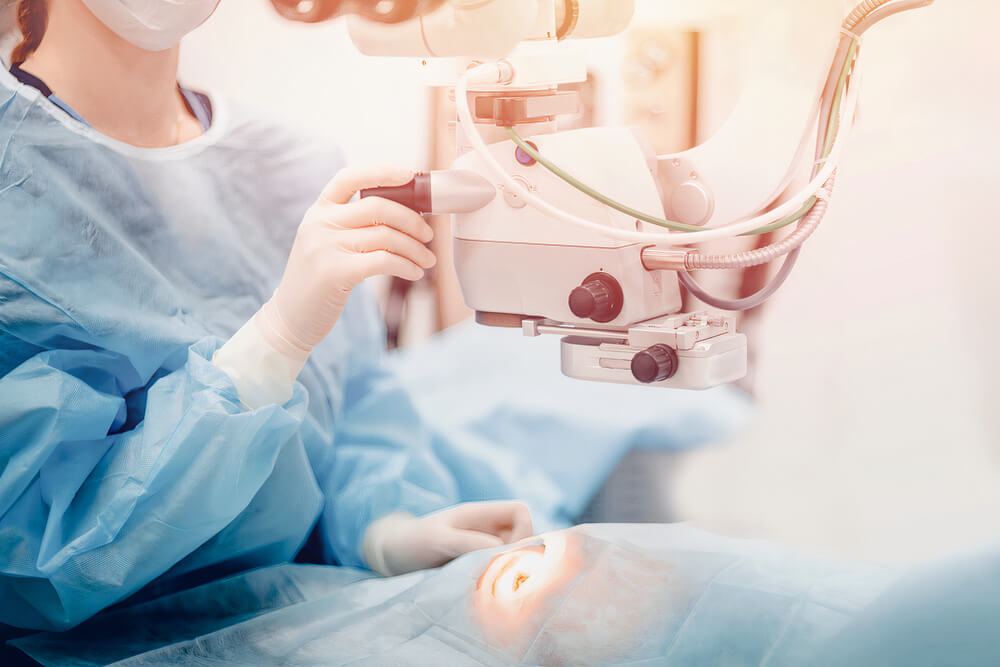2- Surgical correction of hyperopia

The surgical procedures can provide permanent correction of hyperopia, especially for patients with high refraction errors. Before any operation, the patient must have:
-
- The patient should maintain stable refraction error for at least three years before the surgery
- Slit lamp examination to rule out conditions like dry eye or conjunctivitis
- Full evaluation of the patient refractive errors using manual and cycloplegic techniques
- Evaluating corneal thickness
- Measuring intraocular pressure of the patient
- Fundus examination of the eye
- Evaluation of eye pupil size in light and dark conditions
Surgical procedures to correct hyperopia include:
A) Thermal laser keratoplasty
It is a non-contact laser thermokeratoplasty, which is indicated for hyperopia cases with refraction errors from +1 diopters to +2.5 diopters. In this procedure the laser causes dwindling of eight spots on the cornea, eventually this may lead to increase curvature of the cornea.
In a study by John C Hill, he founded that this procedure is slow in refractive errors correction, and do not treat the associated astigmatism.
B) Hyperopic photorefraction keratectomy (PRK)
It is a safe procedure for mild to moderate cases of hyperopia, it can treat a refraction error up to +7.5 diopters. An excimer laser is used to increase the curvature of the cornea. This procedure has a few disadvantages such as:
-
- It can cause dry eye
- Delayed healing of the epithelium
C) Hyperopic laser assisted in situ keratomileusis (LASIK)
Usually used to treat hyperopia patient with reflection error ranges from +1 diopters to +4 diopters and up to +6 diopters. Before LASIK surgery, the patient refractive errors must be stable for a considerable time. Contraindications of LASIK surgery includes:
-
- Chronic eye diseases
- Chronic corneal diseases
- Unstable refractions
- Dry eye
- Chronic pain syndrome
Although LASIK is mostly a safe operation, but a few complications may occur. From these complications
-
- Refraction deterioration
- Post-operative dry eye
- Halo vision
- Difficulty in night vision especially while driving
- Decrease corneal sensation
- Epithelial ingrowth
D) Hyperopic laser subepithelial keratomileusis (LASEK)
In this procedure, they use 20% ethyl alcohol for approximately sixty seconds, then the epithelium of the cornea is separated easily, and an excimer laser is used to perform the stromal ablation. In this procedure flap related conditions are much less in comparison to LASIK procedures, but the patent may experience more post-operative complications as:
-
- Post-operative pain
- Slow healing
This gives LASIK surgery a little bit advantage over LASEK
E) Conductive keratoplasty
This procedure for mild to moderate hyperopia. It is a non-invasive intervention, where low hyperopia could be corrected by using radiofrequency to increase the corneal curvature.
F) Phakic intraocular lens (IOL)
In this procedure, a new intra-ocular lens is introduced in front of the crystalline lens to correct high hyperopia ranges from +4 diopters to +10 diopters. This procedure has a risk of developing cataract later.
G) Refractive lens exchange
It is another option for correcting high hyperopia and can be used in cases if there a contraindication to laser surgeries. Complications of intra-ocular surgeries includes:
-
- Corneal decompensation
- Retinal detachment
- Uveitis
H) Post-operative care for patients with hyperopia
Most refractive errors surgeries are considered safe, and the patient can resume his normal activities after a few days. Patients are advised to follow some instructions after the surgical procedures such as:
-
- Direct after the surgery, the patient is advised to wear dark glasses
- Topical broad-spectrum antibiotic to be applied locally on the eye for five to seven days post-operatively
- Post operative dry eye can be lessen by using artificial tears substitutes
- Avoid post-operative eye rubbing especially just after the operation
- Local cyclosporin eye drops can treat dry eye
- A regular follow up of the patient to assess patient’s refraction, flap conditions, and evaluate for a complication


